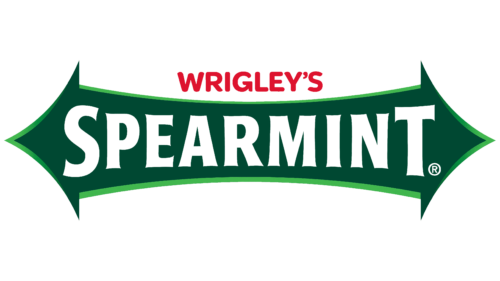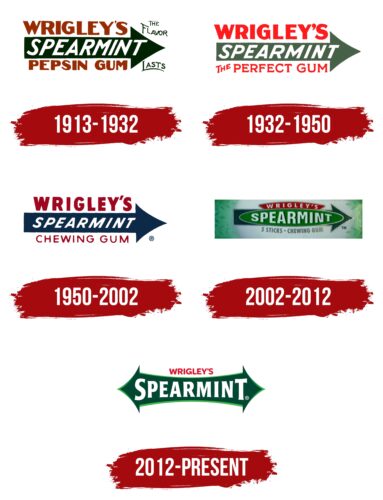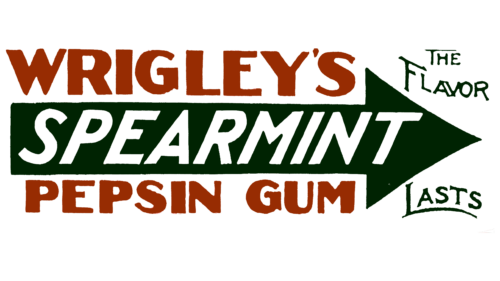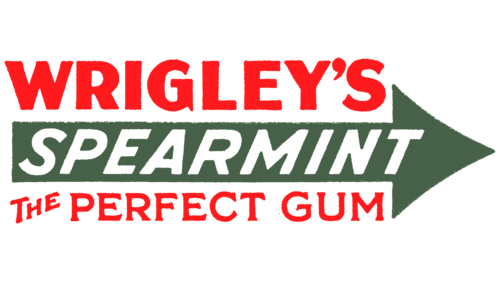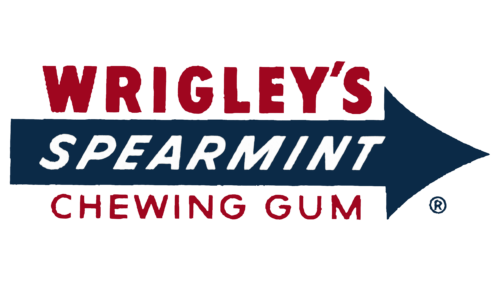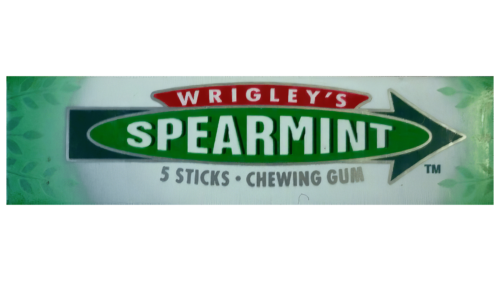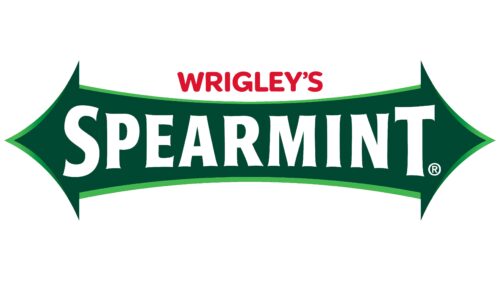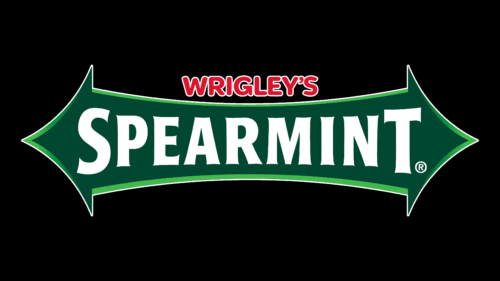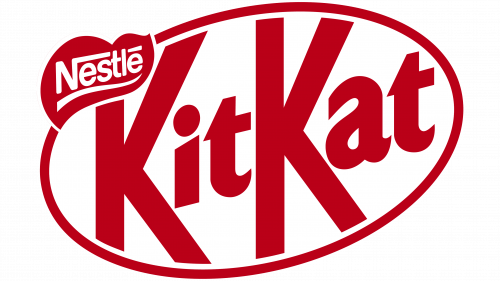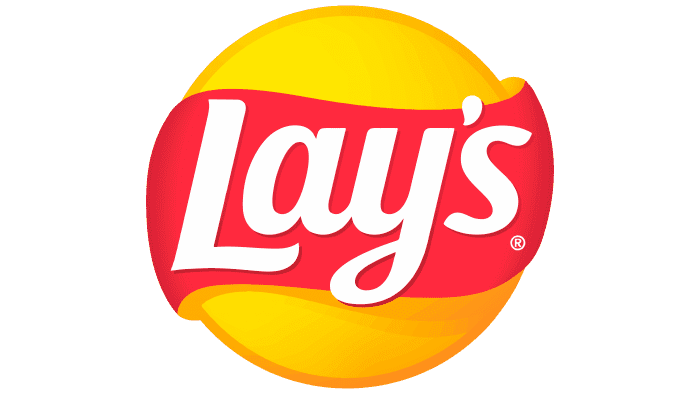The recognizable Wrigley’s Spearmint logo is associated with the minty taste of chewing gum and the manufacturer’s use of natural ingredients. The designers created a visual image of coolness, purity, and freshness to emphasize the brand concept. Moreover, the logo symbolizes the product’s wide availability.
Wrigley’s Spearmint: Brand Overview
Wrigley’s Spearmint is a mint gum whose popularity has not diminished for 130 years. The rights belong to Mars Corporation, which absorbed Wrigley in 2008. Wrigley’s Spearmint logo is known in Europe, Asia, and the United States. The gum business of Wrigley Jr. came about by accident. He came to Chicago to sell soap (1891), and as a bonus, he included baking soda with the purchase. However, the leavening agent turned out to be more in demand. So, the businessman abandoned the soap and got into the soda business. He now used gum as a bonus. When soda was bought for gum, it became clear that Wrigley’s future was chewing gum (1893). Fifteen years later, Wrigley’s Spearmint was bringing in $1 million in revenue.
Since its start in 1893, Wrigley’s Spearmint has become a major part of chewing gum history. William Wrigley Jr., a determined entrepreneur from Chicago, introduced Spearmint at a time when flavors like licorice were the norm. Spearmint brought a new, minty freshness to the market, making it a first of its kind.
In the early 1900s, the gum became very popular because of Wrigley’s innovative marketing and product development. He used modern advertising techniques, such as giving away free samples and using newspaper ads and billboards across the country. This helped make Spearmint stand out with its green packaging and fresh taste, and it quickly became a leader in the market.
The brand grew through tough times like the Great Depression and World War II. During the war, Wrigley sent millions of gum packs to American troops, which helped boost the brand’s image and showed its support for the country. After the war, as social norms changed and the economy grew, more people started chewing gum, which helped Spearmint’s sales.
By the mid-20th century, as the world became more connected, Spearmint reached international markets. Its refreshing taste and recognizable packaging became popular in Europe, Asia, and Latin America. Wrigley kept up with changing consumer tastes by introducing new packaging and product types under the Spearmint brand.
In the late 20th century, Spearmint remained a key product in Wrigley’s collection of gum and candies. Despite new flavors and brands, Spearmint’s classic mint taste continued to be popular. Wrigley also made a sugar-free version to meet health-conscious demands and promoted the gum’s dental benefits.
More than 125 years after it was first made, Wrigley’s Spearmint is still a favorite and well-known brand. The gum market and consumer tastes have changed, but Spearmint’s quality and appeal have lasted. It is now a part of Mars, Incorporated’s portfolio and is enjoyed in over 180 countries. Its mint flavor, refreshing qualities, and green packaging are loved worldwide.
Meaning and History
Wrigley Jr. evolved from a small soap business to a leading chewing gum manufacturer. Its founder, William Wrigley, noticed that people were reluctant to buy soap, so he started selling baking soda and gave each customer two packages of gum. The mini gifts proved much more popular than the main product, and William decided to change his specialization once again. In 1892, he registered the trademark Lotta Gum, and in 1894, Wrigley’s Spearmint appeared. The young businessman dared to do what no one else could: popularize the mint flavor. He created a logo for the new brand for wrappers and advertising.
As a born marketer, William placed the logo in magazines, newspapers, and outdoor posters. At first, the public did not want to accept Wrigley’s Spearmint, but the active advertising promotion and the unchanging logo tipped the scales in a positive direction. Chewing gum is now incredibly popular, and its green arrow is an example of the successful use of symbols to create a recognizable brand.
What is Wrigley’s Spearmint?
A brand of chewing gum with a mint flavor, developed in 1893 by Wrigley and originally sold in Chicago. Now gum is distributed all over the world.
1913 – 1932
The logo was a black arrow to the right, placed on a yellow background, and informative inscriptions.
The main text in large capital letters in italics was placed on the arrow. The word Spearmint translates as “spearmint.” It can be decomposed into two words: “spear” – spear and “mint” – mint. The image of the arrow is most likely this spear. It represents the mint leaf as well as the sharp, rich taste.
The tip looks to the right, showing movement. It indicates the gum’s lingering action. The analogs of that time lost their flavor after just a few minutes, so Wrigley gum stood out advantageously. The inscriptions on the tip of the spear also confirm the idea: the flavor and last, which can be translated as “long-lasting flavor.”
Underneath the spear, it says pepsin gum. Pepsin powder was added to the gum. According to the beliefs of the time, such a product improved digestion. Therefore, gum was not only a pleasure but had a therapeutic effect. The yellow background of the logo supported the theme of health benefits and pleasant, refreshing taste logo.
Above the spear indicates that the gum belongs to the Wrigley Company.
1932 – 1950
In 1932, the company’s founder died, and his son Philip took over the helm. By the 40-s, he achieved the highest sales of Wrigley’s Spearmint. A competent advertising policy and attractive visual signs aided him. The logo of that time was changed and made more harmonious.
The limiting image background disappeared, which gave the sign an airiness associated with gum bubbles. The arrow was replaced by the color of mint leaves instead of bulky black. The element and the lettering now pointed to the mint flavoring.
Spearmint and Wrigley’s inscriptions became larger and balanced each other. And beneath the arrow was the very smug caption “the best gum.” However, given the sales volumes, the message was close to the truth.
1950 – 2002
By ’50, the company had recovered from World War II. Production had to be significantly reduced during the war as the stock of raw materials ran out. Now, production has been restored.
The general appearance of the logo was preserved. The arrow and the name remained. However, their fonts “lost weight,” showing a decrease in income and the difficult times the company had to go through. The bottom lettering has changed. Wrigley’s Spearmint was no longer positioned as the best. The caption was made simple: chewing gum.
2002 – 2012
By the 2000s, the firm was headed by the founder’s great-grandson. In 2002, Mars offered to buy the company, but the parties could not agree. The owner wanted to promote his brands independently, so he rebranded and began conquering new markets.
The visual image of this time acquired several additions. The word Spearmint was located on an oval background placed over an arrow. Its letters, changing size, repeated the oval. This attracted attention to the name and showed the softness of gum and its pleasant, harmonious taste. The company name in small letters was placed on a short red double-edged background on top.
This was the first logo that promoted the brand, not the company. Since the company produced several types of gum (Doublemint, Orbit, Eclipse), each with a minty flavor, it was important to show the customer which brand was hidden in the package.
Below the arrow is very thin, and small letters were added: 5 sticks of gum.
2012 – today
In 2008, the producing company changed ownership, leading to a rebranding. However, Mars Company kept the idea of an arrow as a distinctive feature of Wrigley’s Spearmint.
The logo is a two-pointed arrow. One tip looks to the past, the other to the future. The composition communicates that the brand has come a long way and will go a long way. Both the past and the future are equally important. They are what made Spearmint what gum is today.
The arrow becomes narrower toward the center, which is reflected in the size of the letters, which also decreases toward the middle and increases toward the ends. The lettering shows that the flavor and formulation of the product are perfect and complete. Everything about the product is perfect, from start to finish.
The logo is reminiscent of the construction from stretching the gum by the edges. It evokes the association with the flexibility and malleability of Wrigley’s sticks.
Font and Colors
The green color that dominates the logo is characteristic of many food brands, as it is associated with nature, freshness, and a healthy lifestyle. In the context of Wrigley’s Spearmint, the green color reflects the main taste of chewing gum—mint, which is considered fresh and cooling. It also reflects the traditional flavor of Wrigley’s chewing gum, which has been popular for decades.
The font used in the logo is custom and has no official name. It can be described as a mixture of sans serif and script font. It has a classic look associated with long-standing brands. The name Wrigley’s, written in sans serif, has a modern look. This font makes the logo more recognizable and clear, which helps draw attention to the brand’s products on store shelves.
FAQ
Why is there an arrow on the Wrigley gum?
The arrow on Wrigley gum packaging, especially on Spearmint and Doublemint packs, plays a crucial role in the brand’s identity and advertising. Known as the “Wrigley Arrow,” this symbol originated from the marketing initiatives of William Wrigley Jr., the company’s founder.
William Wrigley Jr. excelled at creating impactful and memorable advertising campaigns. He recognized the importance of having a distinct and easily recognizable symbol to attract consumers and set his gum apart. After introducing Spearmint and Doublemint, he introduced the “Spearmen” characters and the Wrigley Arrow to represent the brand visually.
The arrow symbolizes direction, movement, and progress, representing the forward-thinking and innovative spirit Wrigley wanted his chewing gum to embody. It points consumers towards what he considered a superior product in terms of quality and flavor. The arrow strengthens the brand’s image by linking the gum to a clear and appealing logo. This visual identity ensures Wrigley’s products are noticeable on store shelves and in advertisements, reinforcing the company’s presence in the market.
When was Wrigley’s Spearmint invented?
Wrigley’s Spearmint gum was launched in 1893, shortly after the introduction of Juicy Fruit, making it one of the earliest products in the Wrigley range. Due to its crisp spearmint flavor and refreshing quality, it quickly became a favorite.
From the beginning, Wrigley’s Spearmint has been popular for its refreshing taste, which generations have enjoyed. It has remained a top choice for over a century, becoming a symbol of chewing gum itself. The gum’s lasting presence in the market highlights its appeal and Wrigley’s strong brand identity. For over 100 years, its spearmint flavor has continued to refresh consumers, securing its place as a mainstay in the chewing gum industry and a beloved choice among many.
What happened to Wrigley’s spearmint?
In late 2022, Mars, the current producer of Wrigley’s Spearmint since buying the Wrigley brand in 2008, chose to halt its production in Germany. This decision occurred because of falling sales in the area, suggesting the demand for this gum was decreasing. Faced with these dropping sales, Mars had to think about whether it made sense to keep making the gum for the German market and eventually decided to stop.
This move is part of a larger trend where even well-established products can struggle because of changing tastes, economic shifts, or increased competition. Wrigley’s Spearmint has been a favorite for many years and is a key product in the chewing gum world, but this situation shows that companies need to be flexible and adjust to what the market wants.
Wrigley’s Spearmint is no longer made in Germany, but it’s still sold in other parts where people enjoy it. This highlights how companies like Mars must navigate complex choices when handling well-known brands across different regions.
